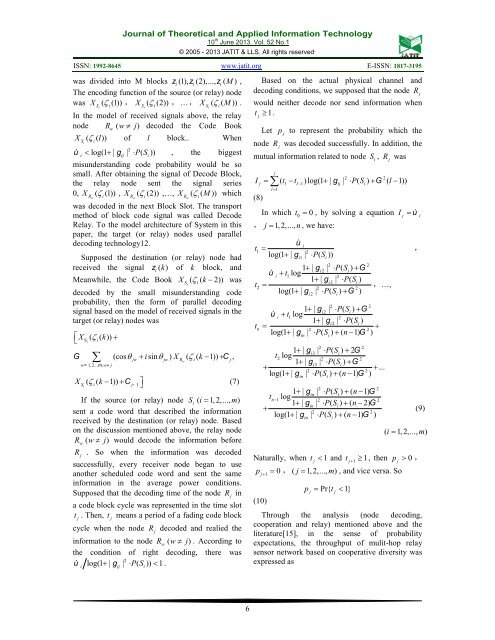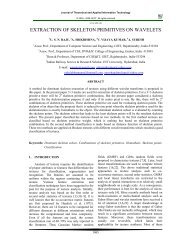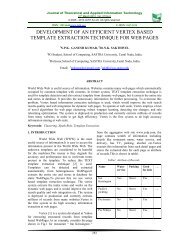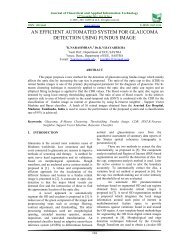Full Text - Journal of Theoretical and Applied Information Technology
Full Text - Journal of Theoretical and Applied Information Technology
Full Text - Journal of Theoretical and Applied Information Technology
You also want an ePaper? Increase the reach of your titles
YUMPU automatically turns print PDFs into web optimized ePapers that Google loves.
<strong>Journal</strong> <strong>of</strong> <strong>Theoretical</strong> <strong>and</strong> <strong>Applied</strong> <strong>Information</strong> <strong>Technology</strong><br />
10 th June 2013. Vol. 52 No.1<br />
© 2005 - 2013 JATIT & LLS. All rights reserved .<br />
ISSN: 1992-8645 www.jatit.org E-ISSN: 1817-3195<br />
was divided into M blocks zi(1), zi(2),..., z<br />
i( M ) ,<br />
The encoding function <strong>of</strong> the source (or relay) node<br />
was X ( ζ (1)) , X ( ζ (2)) ,…, X ( ζ ( M))<br />
.<br />
Si<br />
i<br />
Si<br />
i<br />
In the model <strong>of</strong> received signals above, the relay<br />
node R ( w≠ j)<br />
decoded the Code Book<br />
X<br />
Si<br />
w<br />
( ζ ( l))<br />
<strong>of</strong> l block.. When<br />
i<br />
ù g , the biggest<br />
2<br />
i<br />
< log(1 + |<br />
ij<br />
| ⋅PS (<br />
i<br />
))<br />
misunderst<strong>and</strong>ing code probability would be so<br />
small. After obtaining the signal <strong>of</strong> Decode Block,<br />
the relay node sent the signal series<br />
0, X ( ζ (1)) , X ( ζ (2)) ,…, X ( ζ ( M))<br />
which<br />
Rw<br />
i<br />
Rw<br />
i<br />
was decoded in the next Block Slot. The transport<br />
method <strong>of</strong> block code signal was called Decode<br />
Relay. To the model architecture <strong>of</strong> System in this<br />
paper, the target (or relay) nodes used parallel<br />
decoding technology12.<br />
Supposed the destination (or relay) node had<br />
received the signal z ( k)<br />
<strong>of</strong> k block, <strong>and</strong><br />
i<br />
Meanwhile, the Code Book XS i<br />
( ζ<br />
i<br />
( k−<br />
2)) was<br />
decoded by the small misunderst<strong>and</strong>ing code<br />
probability, then the form <strong>of</strong> parallel decoding<br />
signal based on the model <strong>of</strong> received signals in the<br />
target (or relay) nodes was<br />
⎡<br />
⎣<br />
X ( ( ))<br />
S<br />
ζ<br />
i i<br />
k +<br />
∑<br />
w= 12 , ...m, w≠<br />
j<br />
Rw<br />
G (cosθ + isin θ ) X ( ζ ( k− 1)) + C ,<br />
X<br />
i<br />
Si<br />
jw jw Rw<br />
i j<br />
( ζ ( k − 1)) + C<br />
- ⎦<br />
(7)<br />
⎤<br />
Si<br />
i j 1<br />
If the source (or relay) node Si<br />
( i = 1,2,..., m)<br />
sent a code word that described the information<br />
received by the destination (or relay) node. Based<br />
on the discussion mentioned above, the relay node<br />
R ( w≠ j)<br />
would decode the information before<br />
R<br />
w<br />
j<br />
. So when the information was decoded<br />
successfully, every receiver node began to use<br />
another scheduled code word <strong>and</strong> sent the same<br />
information in the average power conditions.<br />
Supposed that the decoding time <strong>of</strong> the node R in<br />
a code block cycle was represented in the time slot<br />
t<br />
j<br />
. Then, t<br />
j<br />
means a period <strong>of</strong> a fading code block<br />
cycle when the node R j<br />
decoded <strong>and</strong> realied the<br />
information to the node Rw<br />
( w≠<br />
j)<br />
. According to<br />
the condition <strong>of</strong> right decoding, there was<br />
2<br />
ù log(1 + | g | ⋅ PS ( )) < 1 .<br />
i ij i<br />
i<br />
j<br />
Based on the actual physical channel <strong>and</strong><br />
decoding conditions, we supposed that the node R<br />
would neither decode nor send information when<br />
t ≥ 1.<br />
j<br />
Let p<br />
j<br />
to represent the probability which the<br />
node R<br />
j<br />
was decoded successfully. In addition, the<br />
mutual information related to node S<br />
i<br />
,<br />
R<br />
j<br />
was<br />
j<br />
2 2<br />
j<br />
= ∑( l<br />
−<br />
l −1)log(1 + | gij | ⋅ (<br />
i<br />
) + G ( −1))<br />
l = 1<br />
I t t PS l<br />
(8)<br />
In which t 0<br />
= 0 , by solving a equation I<br />
j<br />
= ù<br />
i<br />
, j = 1,2,..., n, we have:<br />
ù<br />
t =<br />
log(1 + | | ⋅PS<br />
( ))<br />
i<br />
1 2<br />
gi<br />
1<br />
2 2<br />
i2<br />
i<br />
ù<br />
i<br />
+ t1 log<br />
2<br />
1 + | gi2<br />
| ⋅PS<br />
(<br />
i)<br />
2<br />
=<br />
2 2<br />
log(1 + | gi2<br />
| ⋅ PS (<br />
i) + G )<br />
t<br />
t<br />
n<br />
=<br />
i<br />
1 + | g | ⋅ PS ( ) + G<br />
1 + | g | ⋅ PS ( ) + G<br />
ù<br />
i<br />
+ t<br />
+<br />
log(1 + | | ⋅ ( ) + ( −1) )<br />
2 2<br />
i2<br />
i<br />
1<br />
log<br />
2<br />
1 + | gi2<br />
| ⋅PS<br />
(<br />
i)<br />
2 2<br />
gin<br />
PSi<br />
n G<br />
2 2<br />
i3<br />
i<br />
2 2 2<br />
+ gi3<br />
⋅ PSi<br />
+ G<br />
2 2<br />
+ gin<br />
⋅ PSi<br />
+ n−<br />
G<br />
,…,<br />
1 + | g | ⋅ PS ( ) + 2G<br />
t log 1 | | ( )<br />
+ + ...<br />
log(1 | | ( ) ( 1) )<br />
t<br />
+<br />
1 + | g | ⋅ PS ( ) + ( n−1)<br />
G<br />
2 2<br />
in<br />
i<br />
n−1 log 1 | |<br />
2 ( ) ( 2)<br />
2<br />
+ gin<br />
⋅ PSi<br />
+ n−<br />
G<br />
2 2<br />
log(1 + | gin<br />
| ⋅ PS (<br />
i<br />
) + ( n−1) G )<br />
j<br />
,<br />
(9)<br />
( i = 1,2,..., m)<br />
Naturally, when t<br />
j<br />
< 1 <strong>and</strong> t<br />
j + 1<br />
≥ 1 , then p<br />
j<br />
> 0 ,<br />
p +<br />
= , ( j = 1,2,..., m)<br />
, <strong>and</strong> vice versa. So<br />
j 1<br />
0<br />
pj<br />
= Pr{ tj<br />
< 1}<br />
(10)<br />
Through the analysis (node decoding,<br />
cooperation <strong>and</strong> relay) mentioned above <strong>and</strong> the<br />
literature[15], in the sense <strong>of</strong> probability<br />
expectations, the throughput <strong>of</strong> mulit-hop relay<br />
sensor network based on cooperative diversity was<br />
expressed as<br />
6
















